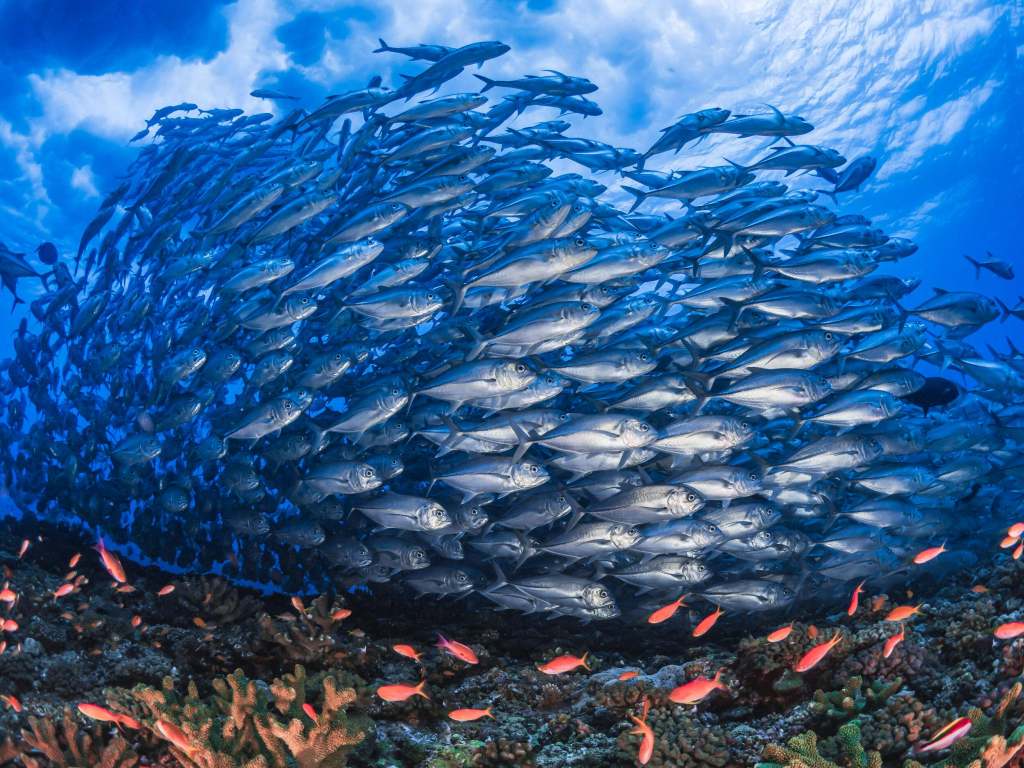Research from TNC’s FAD Watch Program at Palmyra Atoll in the Central Pacific suggests fish aggregating devices (FADs) could be used to retain targeted fish species within the boundaries of marine protected areas (MPAs) long enough to benefit local fish populations.
The Gist
Over the last 20 years, as advanced GPS and fish-monitoring technologies became more affordable, “they revolutionized the way commercial fishing fleets operate,” says co-author Michael Bode from Queensland University of Technology. “Drifting FADs, called dFADs attract schools of fish, let the fishers know where and how many there are. That makes them easier and cheaper to catch.”
Which got scientists thinking. Since dFADs are so effective at aggregating pelagic fish, like tuna, billfish and mahi mahi for catching, maybe they could also be used for aggregating fish for conservation inside marine protected areas.
They began crunching numbers and running models and the results of their findings, published in Conservation Letters, say, “Yes.”
“By putting what we’re calling ‘Conservation FADs’ (cFADS) inside MPAs, we could increase the time that species like tuna spend in those MPAs (where they can’t be caught), thereby reducing mortality rates,” says co-author Edward T. Game, TNC’s Asia Pacific lead scientist and director of conservation. “Somewhat amazingly, we found that even a small number of cFADs inside a blue water MPA can meaningfully amplify the benefits of that MPA.”
The Big Picture
As noted in the paper, blue water MPAs are large-scale (> 100,000 km2) protected areas that encompass open ocean, pelagic ecosystems, although they are often centered upon oceanic islands, reefs, or seamounts. The number and extent of blue water MPAs has accelerated rapidly in recent years and is likely to continue to accelerate in support of international agreements such as the Convention on Biological Diversity’s post-2020 Global Biodiversity Framework.
However, there remains significant and intense scientific debate about how effective MPAs are for conserving those pelagic species and ecosystems. Why? Well, oceans are large and pelagic species—especially fish—tend to be highly mobile, or migratory (or both). They also obviously don’t recognize the legal boundaries of an MPA where they would be safer from fishing pressures.

There is no MPA big enough to solve that problem so increasing the conservation benefits of new and existing blue water MPAs through novel techniques, like cFADs, could be key to maximizing their effectiveness.
According to the researcher’s models, despite the temporary nature of cFAD protection, it could nevertheless enhance stock levels, via the same mechanism as temporary closures. An increased residence time could deliver density-dependent ecosystem benefits, which are lost when commercial fishing reduces the abundance of target or bycatch species. For instance, bird species often rely on high tuna densities for effective foraging
The Takeaway
“As governments and conservation groups world-round set sights on protecting 30% of the world’s ocean habitat by 2030, figuring out how to maximize the value of protected ocean patches for pelagic species should be a key objective,” says Alex Wegmann, Ph.D., co-author of the paper and lead scientist for TNC’s Island Resilience Strategy.
Conservation FADs—which would stay within the boundaries of the marine protected area—could amplify the benefits of blue water MPAs. The researchers note that “this amplification is largest in those contexts where blue water MPAs have attracted the most criticism—when their area is small compared to both the open ocean and the distribution of fish stocks that move through them.”
Palmyra is a TNC preserve within a US Fish and Wildlife Service National Wildlife Refuge and further protected—out to 50 nautical miles—by the Pacific Remote Islands Marine National Monument, the largest swath of ocean and islands protected under a single jurisdiction in the world. Palmyra Atoll is of global significance for blue water MPA, small island and coral reef research—especially in the face of climate change. It is one of the only marine environments that is spectacularly intact and offers TNC’s research facilities to enable discoveries with application far beyond Palmyra.



